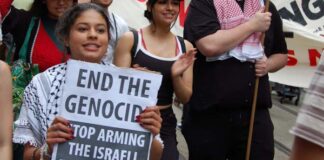Direct action protests that disrupt business as usual should not be seen as an end in themselves but as part of a broader strategy of mass action, writes Adam Adelpour
The horror of Israel’s onslaught in Gaza has provoked millions around the world to take to the streets and protest.
Albanese’s government remains appallingly complicit.
Albanese has continued trade with Israel, including military trade, and has handed a huge $917 million contract to Israeli arms company Elbit Systems. Over 70 Australian companies make parts for the F-35 fighter jets used by Israel to bombard Gaza.
It is clear that if he was going to be convinced to act by the moral criminality of Israel’s actions he would have done it by now.
Faced with this reality growing numbers of people have seen the need to escalate beyond the weekend street marches. There is a sense that if our voices aren’t being listened to by politicians we have to take actions that can’t be ignored.
Direct action
This has led to a growing desire to engage in direct action.
While there is not a single definition of direct action, in general it refers to actions of small groups of protesters taking more or less disruptive action to attract attention, such as blocking roads, occupying buildings, activists locking themselves to industrial equipment, cranes or factory gates.
A wide variety of recent actions in Australia have been referred to as direct action.
These include a small group of protesters locking themselves onto machinery at Wollongong’s Bisalloy steel plant, which has contracts with the IDF, mass pickets of hundreds blocking ports when Israeli shipping line ZIM has ships in port and graffiti on ABC buildings in response to their biased pro-Israel coverage of the genocide in Gaza.
It is absolutely right that we have to find ways to disrupt business as usual in the face of Israel’s genocide and the Albanese government’s complicity.
But the direct action of small groups, who are often fascinated with planning secretive, small disruptive activities while understandable can, in the longer run, be self-defeating.
Such actions focus on heroic individuals or small groups taking the action—something that does not have the same power as mass direct action involving hundreds or thousands of people.
This problem was well described by the late revolutionary socialist John Molyneux, who wrote that supporters of direct action insisted on the tactic:
“to the exclusion of other forms of action, and to disparage other forms of protest. With this goes a tendency to exalt the excitement, danger, courage, and attention grabbing qualities of direct-action ABOVE the need to involve and mobilise the masses.”
But direct action protests can only disrupt a company temporarily, holding up work for a few hours until police arrive. They do not have the ability to permanently stop production of weapons or trade with Israeli companies.
This means direct action protests cannot be judged purely in terms of the amount of disruption they cause. They can play a powerful role as a statement of intent about the movement’s determination to sanction Israeli companies or stop the arms trade.
But they have to be aimed at creating a political crisis through drawing attention to the role of Australian companies in aiding Israel’s genocide as well as Albanese’s support for them, and drawing larger numbers of people into action as part of the movement as a whole.
This is only possible if direct action involves large numbers of people—rather than individuals or small groups who can be far more easily ignored—and is directly connected with a working class orientation to mobilise the workers, and the unions, in the armament factories, to take action themselves.
Lessons from Vietnam
The history of the movement against Australia’s involvement in the Vietnam War shows both the radicalising role of mass direct action and why it is most effective when it is connected to a wider movement—and aimed at building the wider movement’s support.
The first protests against conscription and Australia’s involvement in Vietnam from 1965 were on the fringes of society. Only hundreds mobilised, alongside actions by a handful of left-wing trade unions.
Direct actions punctuated the development of the movement, helping radicalise it and shift it to the left.
Students began engaging in sit-ins on roads and at government offices to oppose Australia’s involvement in Vietnam and conscription.
The fact that these actions involved hundreds of people meant the experience of repression by police and the authorities radicalised large numbers, with many students abandoning their initial pacifism in the face of state violence.
By 1967 Monash uni students were raising funds for the Vietnamese National Liberation Front and in 1968 thousands of students waged pitched battles with police at the US consulate.
The repression of those resisting conscription had a similar effect, pulling wider layers into the movement and shifting it to the left. Radicalism wasn’t a barrier to building a bigger movement, it was essential to it.
As a result by 1970 the Vietnam Moratorium marches saw much larger numbers on the streets—and mass workers strike action to “Stop work to stop the war”—with 100,000 marching in Melbourne and 25,000 joining the action in Sydney.
By 1971 the conservative government was forced to announce the withdrawal of Australian troops under the combined pressure of the Vietnamese resistance and the protest movement at home.
At the same time, direct actions were only able to have such an effect because they were combined with mass organising on a huge scale.
Unions and the Labor Left joining the movement gave it legitimacy and meant it reached wider sections of the working class.
Direct action was an important part of the movement overall, but it was also only one part.
What kind of direct action?
The actions against ZIM shipping around the country have highlighted the need for a strategy that goes beyond simply celebrating direct action.
The mass community pickets at the port have effectively highlighted the economic ties between Australia and Israel, provided an avenue for escalation beyond street marches and opened the door to union participation in actions at the ports.
But they have also faced fierce police repression with community pickets being dispersed by police. Around 40 people have been charged under draconian anti-protest laws in NSW as a result.
The involvement of hundreds of people has delivered a significant impact both in raising the pressure on the government for sanctions on Israel and in radicalising many people taking disruptive action for the first time.
But the most effective action against ZIM shipping would be workers banning work on ZIM ships. This kind of action by port workers helped isolate apartheid South Africa.
Workers’ bans are far more effective than the temporary disruption of community pickets. If port workers refused to handle certain goods it would permanently stop them coming into the country.
Workers have often refused to work on particular contracts or projects in the past, from bans on uranium mining to bans on Indonesian companies during the crisis over East Timor in 1999.
Workers’ bans are also harder to deal with using force alone. Police can use violence to move a community picket off the road, but they can’t load ships themselves.
With this in mind, it is strategically essential to combine community pickets with efforts to build support inside the container terminals amongst workers, to build wider political support for actions and to work alongside the Maritime Union of Australia to maximise the involvement of unions and workers.
On 25 May there will be national mass marches on the ports calling to end all trade with Israel.
Through a purely direct action lens such actions are a step backward from disruptive mass pickets. But if the goal is to work towards bans by workers then marches on the ports are important.
They can help unite more unions, workers and other organisations behind our demands, build more confidence to defy anti-protest and anti-strike laws and raise workers’ awareness about why they should oppose trade with Israel.
All this is a precondition of workers’ industrial action against Israel—the most effective form of direct action.
There are other recent examples of the limits of minority direct action in disrupting business as usual, and the way that mass action and workers’ power are necessary to actually win demands.
In April small groups of Google workers were involved in courageous sit-ins at Google offices in New York and Sunnyvale, California, protesting the company’s cloud-computing contract with the Israeli government.
Their strident actions put the spotlight on Google’s complicity and made a splash in the media around the world.
But Google responded by sacking 50 workers, including those who actually participated in sit-ins as well as some supportive bystanders. Because a small minority can easily be sacked, much wider involvement in action by Google workers is the only way to defend against reprisals and force Google to cut its ties with Israel.
This requires patient work by the activist minority to win the majority of the workforce to take action against their bosses.
A successful strike or union ban requires wide enough support that a firm majority joins the action—as even a significant minority of workers setting out the break the strike through scabbing can undermine the action.
As the situation in Rafah worsens there will be many looking for what can be done.
Understanding the experience of the movement since 7 October and the history of the movement against the Vietnam War, we can see that direct action can play an important role.
But it has to be mass direct action which is actively, dynamically connected to the wider movement to break ties with the Israeli terror state.






